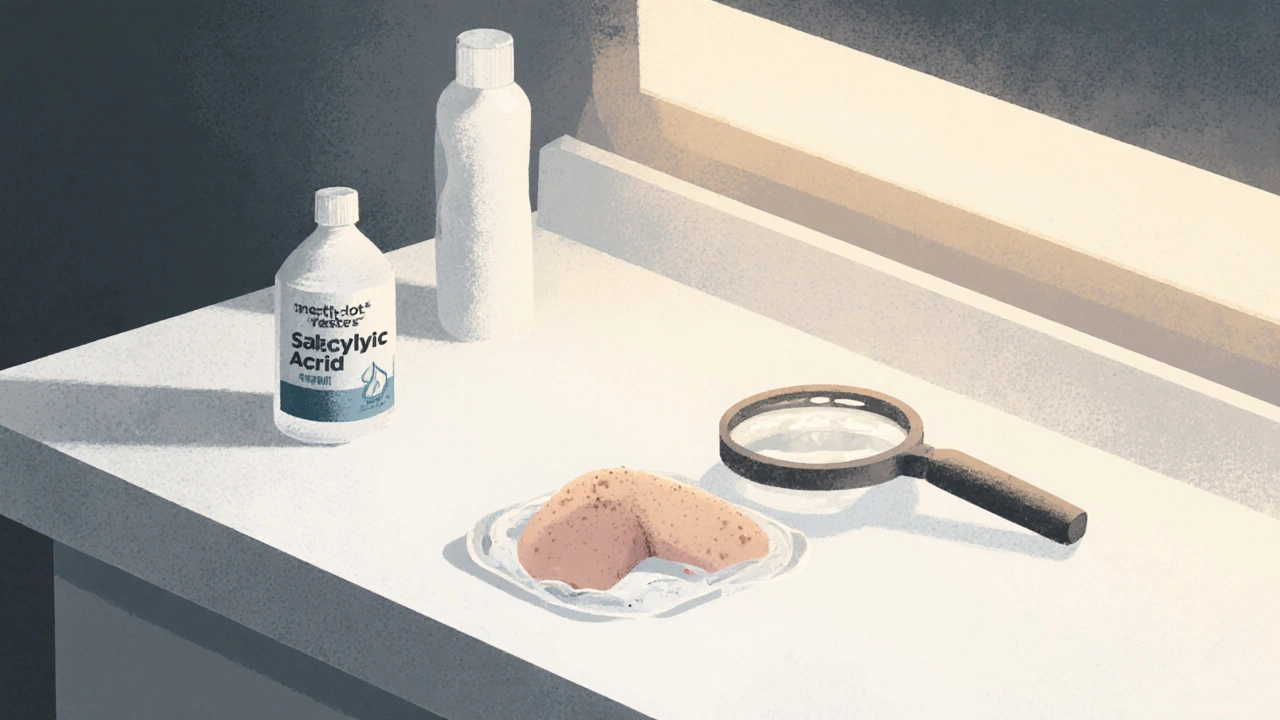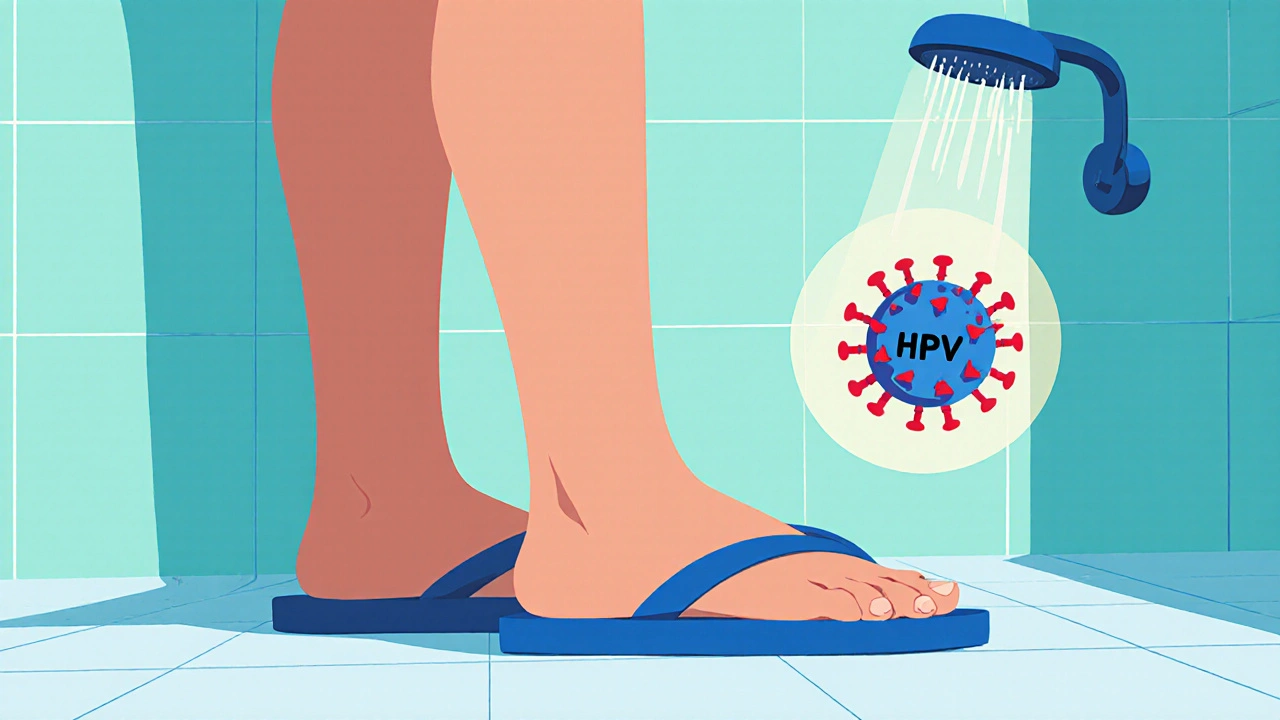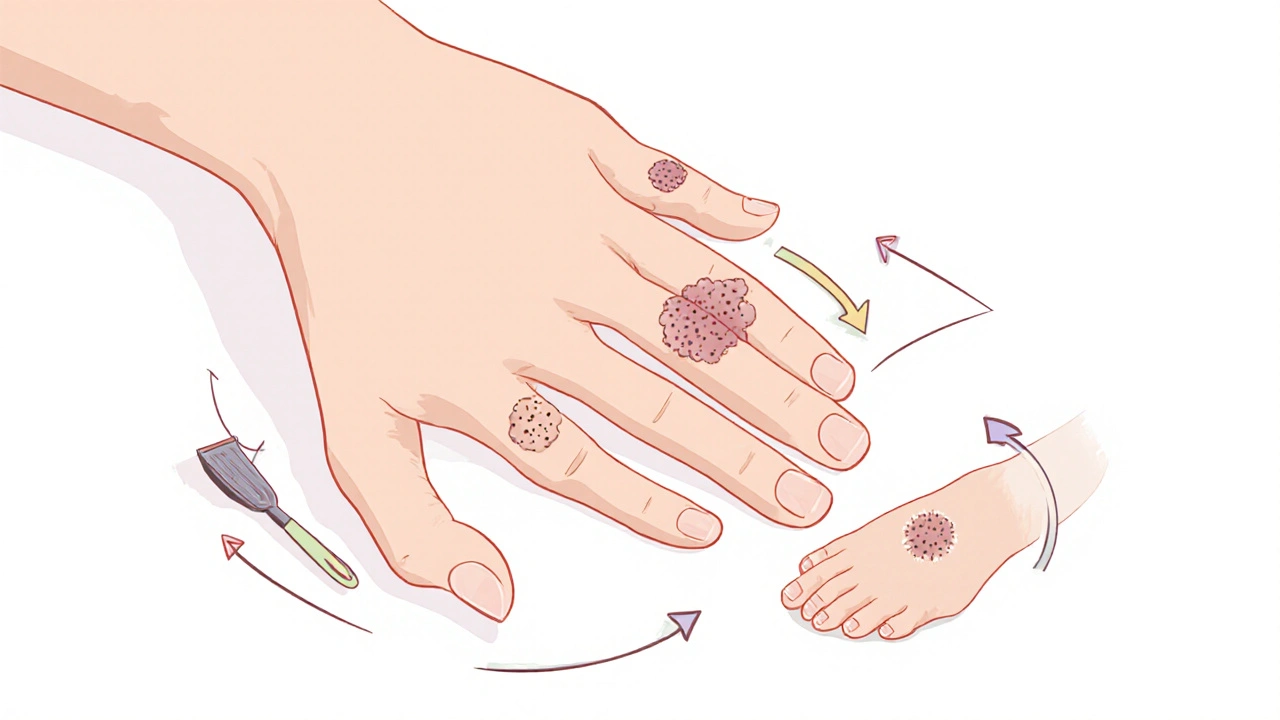Warts might seem like a harmless annoyance, but they’re not just skin deep. They’re caused by the human papillomavirus (HPV), a group of over 100 virus strains that invade the top layer of your skin. You don’t need to be sick or weak to get them - you can pick them up from touching a surface someone else with warts has touched, or even from shaving over a wart and spreading it to another part of your body. They show up on fingers, hands, feet, or even the face, and while they often go away on their own, many people want them gone faster - for comfort, appearance, or to stop them from spreading.
How HPV Turns Skin Into Warts
Not all warts are the same. Different HPV strains target different areas. Types 1, 2, and 4 are the usual suspects behind common warts - those rough, raised bumps you see on fingers or knuckles. If you’ve got flat, smooth bumps on your face or legs, that’s likely HPV types 3 or 10 - called flat warts. And if you’re dealing with a painful, hard growth on the bottom of your foot, that’s a plantar wart, usually caused by HPV types 1, 2, 4, 60, or 63. These can feel like stepping on a pebble, especially when you walk.
Warts spread easily. If you bite your nails and have a wart near your cuticle, you might end up with more around your mouth. If you shave over a wart, you can scatter the virus to other areas. Kids are more likely to get them - up to 24% of children in some studies - because their immune systems haven’t fully learned how to fight off HPV yet. Adults are less affected, but still vulnerable, especially if they have cuts, dry skin, or weakened immunity.
Do Warts Go Away on Their Own?
Yes - and that’s the frustrating part. About 60 to 70% of warts disappear without any treatment within two years. Your immune system eventually recognizes the virus and clears it. But waiting isn’t always practical. Warts can multiply. They can hurt. They can make you self-conscious. And if you have one on your foot, walking becomes a chore. That’s why most people don’t wait. They want answers now.
The good news? You have options. The bad news? Not all of them work the same for everyone. What works for your friend might not work for you. Treatment depends on the type of wart, where it is, how long it’s been there, and your tolerance for discomfort or cost.
Topical Treatments: Salicylic Acid and Beyond
The most common and well-studied home treatment is salicylic acid. You can buy it over the counter in liquid, gel, or patch form, with concentrations between 17% and 40%. It works by slowly peeling away the infected skin layer by layer. It’s not flashy, but it’s effective - one major study of over 1,800 patients found an 84% success rate for plantar warts when used correctly.
Here’s how to use it right: Soak the wart in warm water for 10 minutes, then gently file it with an emery board or pumice stone (use a different one for healthy skin). Apply the acid directly to the wart, avoiding the surrounding skin. Do this daily. It takes patience - most people need 6 to 12 weeks of consistent use before results show. Skipping days or stopping too soon is the number one reason it fails.
Other acids like trichloroacetic acid (TCA) are stronger and usually applied by a dermatologist. It works faster, often in just a few sessions, by burning off the wart tissue. But it can sting, and if applied wrong, it can scar. It’s best for stubborn warts on palms or soles.

Cryotherapy: Freezing Them Off
Freezing warts with liquid nitrogen is one of the most common in-office treatments. Dermatologists spray it directly onto the wart, freezing the tissue to a depth of 2-3mm beyond the visible edges. The frozen skin blisters and falls off in 1-2 weeks. It’s quick, doesn’t need anesthesia, and is safe for kids.
But here’s what most people don’t know: timing matters. A 1976 study showed that treating warts every 2-3 weeks gave a 75% success rate. Stretch it to 4 weeks, and that number dropped to 40%. Most patients need 3-6 sessions. If your doctor only does one or two visits and calls it quits, you might be setting yourself up for failure.
Studies comparing cryotherapy to salicylic acid found no major difference in effectiveness after 12 weeks. Both work. But cryotherapy is faster - you see results sooner. It’s also more expensive and requires a clinic visit. If you’re willing to stick with daily applications, salicylic acid can be just as good - and cheaper.
When the Basics Don’t Work: Immunotherapy and Lasers
If you’ve tried salicylic acid and freezing and nothing’s worked, it’s time to think differently. Instead of attacking the wart directly, some treatments train your immune system to fight the virus. That’s where imiquimod cream comes in. It’s applied 2-3 times a week and causes local inflammation - which sounds bad, but it’s actually your immune system waking up. It’s especially useful for flat warts and warts that keep coming back.
Another option is cantharidin, a substance derived from blister beetles. Dermatologists paint it on the wart, and it creates a controlled blister under the wart, lifting it off. It’s painless during application and works well for children who can’t handle freezing or acid.
For the most stubborn cases - warts that have survived multiple treatments - doctors may turn to laser therapy. Pulse dye lasers target the tiny blood vessels feeding the wart. The wart turns dark purple or black right after treatment and falls off in a week or two. It’s precise, but expensive and not always covered by insurance. Electrosurgery (burning with an electric needle) is another option, but it carries a higher risk of scarring.

What Doesn’t Work - And Why
There’s a long list of treatments that sound promising but lack solid proof: silver nitrate, zinc, citric acid, phenol, formic acid. Some work in rare cases, but no large, reliable studies back them up. Surgical cutting is rarely recommended anymore. Even if you remove the wart, the virus often stays in the surrounding skin, and it grows back. One dermatology review found recurrence rates were high after excision because the virus wasn’t fully eradicated.
And don’t fall for the “duct tape cure.” A few small studies suggested it might help, but larger reviews found no real benefit over placebo. It’s not harmful, but it’s not reliable either.
Preventing Spread - And Re-Infection
Treating the wart isn’t enough. You need to stop it from spreading to other parts of your body or to other people. Here’s what you should do:
- Don’t pick, scratch, or bite warts - you’ll spread the virus.
- Use separate towels, razors, and nail clippers. Wash them after each use.
- Wear flip-flops in public showers, pools, and locker rooms.
- Keep your skin moisturized - dry, cracked skin is easier for HPV to enter.
- If you’re using salicylic acid, file the wart with a disposable emery board and throw it away after use.
HPV thrives in warm, damp places. That’s why plantar warts are common in athletes and swimmers. Even after the wart is gone, the virus can linger on your skin for months. So hygiene isn’t just a suggestion - it’s part of the treatment.
Realistic Expectations
There’s no magic bullet. Even the best treatments require time and repetition. You might need six visits to the dermatologist. You might need to apply acid every day for three months. You might try one thing, fail, then try another. That’s normal.
Success isn’t about speed - it’s about consistency. Most people who get rid of warts do so because they stuck with it. Those who quit early end up with the same wart - or worse, a dozen new ones.
The bottom line? Start with salicylic acid at home. Be patient. If it doesn’t work after 12 weeks, see a dermatologist. Cryotherapy is the next step. For stubborn cases, immunotherapy like imiquimod can be a game-changer. And remember - your immune system is your strongest ally. Treatments just help it along.


Comments (13)
Salicylic acid? Please. I’ve seen guys in Texas remove warts with duct tape and a BB gun. If you’re not willing to go full survivalist, you’re just wasting time. This whole article reads like a textbook written by someone who’s never held a pumice stone.
Okay but like… why is everyone so obsessed with ‘treating’ warts?? 😅 I had one on my pinky for 3 years. It just… vanished one day. Like it got bored of me. 🤷♀️✨
so like… i tried salicylic acid for 3 weeks and it just made my skin look like a crumpled paper bag?? i think the real cure is just ignoring it until your immune system gets tired of the drama. also why does everything have to be so medical?? 🤮
It’s fascinating how the article frames HPV as some kind of invader rather than a co-evolved commensal. The immune system doesn’t ‘clear’ HPV - it tolerates it. The real issue is not the virus, but our pathological aversion to any biological imperfection. This entire discourse is a product of capitalist dermatology, where ‘removal’ is monetized as ‘cure.’ The fact that 70% resolve spontaneously proves the treatment industry is built on manufactured urgency. Salicylic acid? A placebo with exfoliation. Cryotherapy? A thermal assault on epidermal integrity. The only ‘effective’ treatment is epistemological humility - accepting that skin is not a canvas to be perfected.
man i tried the acid thing and it worked but only after i stopped being lazy and did it every day like they said. i kept skipping days because i thought ‘it’ll go away on its own’ and then i had 3 more. lesson learned: consistency > hope. also dont use the same emery board for your nails and the wart. trust me.
Let me be clear: if you’re using over-the-counter salicylic acid, you’re not treating a wart - you’re performing a half-baked, amateurish ritual. The only legitimate path is dermatological-grade TCA, administered by a licensed professional. Anything less is just vanity-driven self-sabotage. And please, for the love of medical science, stop believing in ‘immune system miracles.’ Your body doesn’t ‘get tired’ of viruses - it’s either competent or it isn’t. And if it isn’t, you’re just delaying the inevitable.
There’s something deeply human about how we treat warts - like they’re moral failings instead of biological accidents. We shame them. We hide them. We attack them with acid and fire and duct tape. But they’re just skin. They don’t know they’re ‘wrong.’ Maybe the real treatment isn’t removing them, but learning to live with the fact that our bodies are messy, viral, imperfect ecosystems. The wart doesn’t need to be erased - it just needs to be seen without judgment.
Okay but imiquimod is the REAL MVP. I had flat warts on my forehead for 14 months. Tried everything. Then I used imiquimod 3x a week for 10 weeks - it burned like hell, my skin looked like a war zone, but boom - gone. No scars. No regrets. Just a clean forehead and a newfound respect for immunology. Also, if you’re using it, don’t touch your eyes. I learned that the hard way. 🤕
i just let mine be. it’s been there 8 months. i don’t touch it. i don’t think about it. sometimes i forget it’s even there. i guess i’m just not that into fighting my own skin. peace out, little wart.
you got this. seriously. i know it’s frustrating when nothing works, but you’re not alone. i had plantar warts for years - cried in the shower, hated wearing sandals. then i stuck with salicylic acid for 16 weeks. didn’t quit. didn’t give up. and now? no warts, no drama. just feet that don’t hurt when i walk. you’re stronger than you think. 💪
why do people treat warts like theyre evil? theyre just viruses trying to survive like everything else. stop the war. just wash your hands and wear flip flops. done. no need for acid or lasers or crying in the bathroom
Wow. 1800 patients. 84% success. You’re telling me the entire medical community is just… guessing? And you’re still using duct tape? I’ve seen your Wikipedia edits. You believe in homeopathy. Of course you’d trust tape.
Let’s be real - if you’re not using cryotherapy or laser, you’re just doing cosmetic theater. And salicylic acid? That’s for people who can’t afford a dermatologist or don’t have the discipline to show up. The fact that this article even mentions duct tape as a ‘myth’ is laughable. It’s not a myth - it’s a cult. And you’re all its followers.